All Management Events
- SRM AP’s collaboration with IIRS-ISRO enable students to avail outreach programmes June 23, 2020
 SRM University AP-Andhra Pradesh has collaborated with the Indian Institute of Remote Sensing (IIRS) -Indian Space Research Organization (ISRO)’s outreach programme. SRM AP is included among the top-notch universities of India that can benefit from the incomparable Outreach Programme. As part of the association, the students of SRM AP will have the excellent opportunity to register for annual courses as well as live and interactive programmes being organized by IIRS. In addition, E-learning courses for a short span of 3-4 Month duration will be accessible by the students.
SRM University AP-Andhra Pradesh has collaborated with the Indian Institute of Remote Sensing (IIRS) -Indian Space Research Organization (ISRO)’s outreach programme. SRM AP is included among the top-notch universities of India that can benefit from the incomparable Outreach Programme. As part of the association, the students of SRM AP will have the excellent opportunity to register for annual courses as well as live and interactive programmes being organized by IIRS. In addition, E-learning courses for a short span of 3-4 Month duration will be accessible by the students. Please view the annual course calendar 2020 here
Please view the annual course calendar 2020 here ISRO is among the best-performing government organizations in India which has mastered the sophisticated space technologies, along with receiving applauds globally. The organization’s brilliant research and development, and applications for societal benefits like tele-education, telemedicine, disaster management, agriculture, fisheries and infrastructure development, ensures its dominance in the world. ISRO has launched the IIRS Outreach Programme to strengthen academia in terms of Space Technology & its applications through online learning platforms.
The popularity of remote sensing, geographical information system, global navigation satellite system and associated geospatial technologies in the current times require trained manpower in the domain. The students of SRM AP are encouraged to proactively avail the interactive distance learning courses and webinars that will enable the students to achieve their career goals in aerospace and geospatial technologies and make a mark globally.
Know more about Registration: https://elearning.iirs.gov.in/outreach.php
Register here: https://elearning.iirs.gov.in/Registration.php
 Click here to know more about the registration procedure
Click here to know more about the registration procedureFor additional information or clarification, please contact programme coordinator:
Prof. Siva Sankar Yellampalli
Continue reading →
Professor of Practice & Head of the Department,
Department of Electronics and Communication Engineering
E-mail: sivasankar.y@srmap.edu.in
Contact No: 7760280268 - 5G workshop in collaboration with IEEE-SRM Student Branch June 23, 2020
Continue reading →
Registration Link : https://bit.ly/srmapieee
Find the detailed Brochure here :

- Department of Chemistry, SRM AP organizes webinar on “Chemistry is every day’s science” June 20, 2020
Chemistry is often called the “CENTRAL SCIENCE” as it plays a pivotal role in all aspects of physical and biological sciences, including engineering, agriculture, medicine, and allied health disciplines. Department of Chemistry, SRM University-AP, Andhra Pradesh organizes a webinar titled “Chemistry is every day’s science” on 26 th June 2020 from 11.00 a.m. to 12.00 p.m. The session will provide high school students with opportunities to learn and interact with young faculty members who are genuinely passionate about chemistry. The webinar will illustrate the essentiality of chemistry in everyday life, and how its importance can ignite an interest in many young students to pursue a career in science.
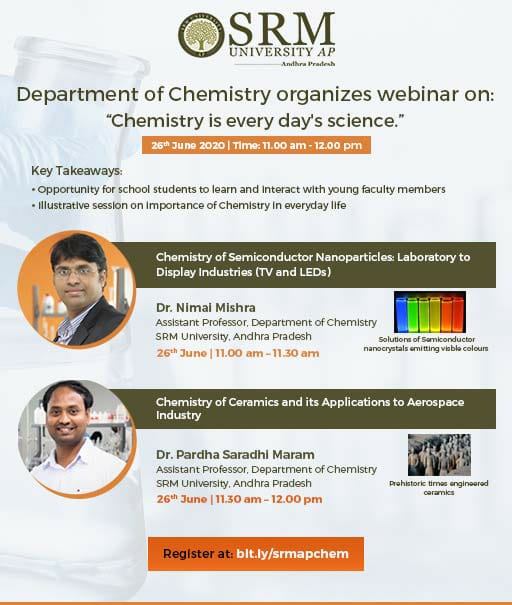

Solutions of Semiconductor nanocrystals emitting visible coloursDr. Nimai Mishra, will be initiating the webinar as the first speaker. In the 30-minute duration of his talk beginning at 11 a.m., Dr. Mishra will be giving a speech on “Chemistry of Semiconductor Nanoparticles: Laboratory to Display Industries (TV and LEDs).” Semiconductor nanocrystals are tiny light-emitting particles on the nanometer scale, having optical and electronic properties that differ from larger particles due to quantum mechanics. Nanoparticles can be made in the Chemistry laboratory with the help of some simple chemical reactions. These semiconductor nanocrystals are valued for displays because they emit pure light, which can be used in electrical appliances (TV and LEDs) with visibly more accurate colours. In the talk, Dr. Mishra will discuss how simple Chemistry in the laboratory can contribute to making modern electrical appliances.
Presently (from November 2017), Dr. Mishra is working as an Assistant Professor in the Department of Chemistry at SRM University-AP, Andhra Pradesh. Before joining SRM-AP, he worked as a postdoctoral research scientist in the Department of Nanochemistry at the Italian Institute of Technology (IIT)-Genova, Italy. Prior to that, Dr. Mishra completed three years (April 2013 –June 2016) as a postdoctoral fellow in the Center for Integrated Nanotechnologies (CINT) at Los Alamos National Laboratory (LANL), USA. Dr. Mishra received his Ph.D. degree in March 2013 from the Department of Chemistry at the National University of Singapore (NUS), Singapore, and completed his M.Sc. in Chemistry from IIT-Madras.

Prehistoric times engineered ceramicsDr. Pardha Saradhi will begin his half an hour talk from 11.30 am. His speech will encompass “Chemistry of Ceramics and its Applications to Aerospace Industry.” Ceramics is one of the most ancient industries which has its roots going back thousands of years. Ceramics is a very general phrase; it includes a wide variety of materials that covers from decorative pottery to the aviation industry. Ceramics possess unique features and are identified by their properties such as high hardness, brittleness, chemical stability, and low thermal conductivity. After World War II, ceramics and glass have contributed to the growth of many technologically advanced fields, including electronics, optoelectronics, medical, energy, automotive, aerospace, and space exploration. The scheduled talk of Dr. Pardha Saradhi will focus on various ceramic materials and the chemistry behind making lightweight and high strength ceramics for the Aviation industry.
Dr. Maram Pardha Saradhi received a Ph.D. in Solid State Chemistry from the Department of Chemistry, Indian Institute of Technology, Madras. After postdoctoral work at the University of California, Dr. Pardha Saradhi moved to a catalyst industry where he headed diesel oxidation in the catalyst division. Later, he joined as the faculty in Chemistry at SRM University-AP, Andhra Pradesh. His research interests include Environment protection and Energy Conversion relating microscopic features of structure and bonding to macroscopic thermodynamic behaviour in complex functional materials. The main technical areas that his laboratory is working on is materials for Li-ion and beyond Li-ion batteries, mixed metal oxide catalysts for two-way and three-way emission control systems, and high-temperature ceramic materials for aerospace applications.
Registration Link: https://bit.ly/srmapchem
Continue reading →
The Hindu – June 15

The Hans – June 14
Times of India – June 15
Outlook India – June 15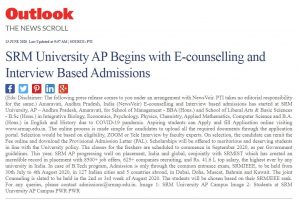
The Week – June 13
Mangla Times – June 13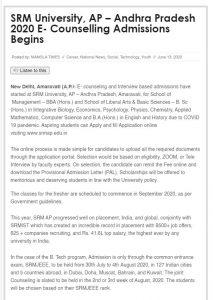
Careers360 – June 13
The Pioneer – June 15
The Photo Chronicle – June 14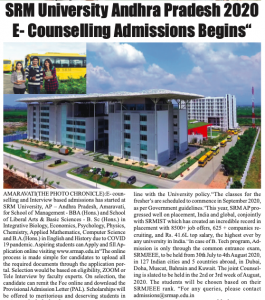
The Truth One – June 15
Today India – June 13
United News of India – June 15
Global Greenews – June 15
Morning Updates – June 15
AINCNEWS – June 15
ANI – June 15
APEKSHA – June 15
Cqai520 – June 13
English Lokmat – June 15
Fasak24x7 – June 13
Goa Chronicle – June 15
GraphBuzz – June 15
ibtn9 – June 15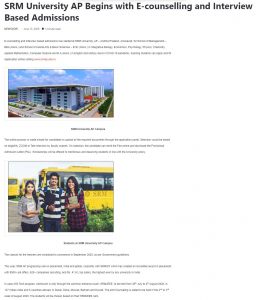
India Educationdiary – June 15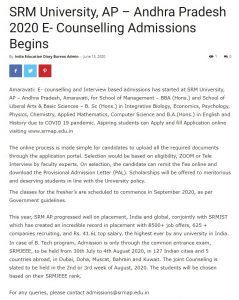
Newsr – June 15
Newsreach – June 15
NewsReaderBoard – June 15
Press Trust of India – June 15
Rediff REALTIME News – June 15
State of Affairs – June 13
Subhodayam Subbarao – June 15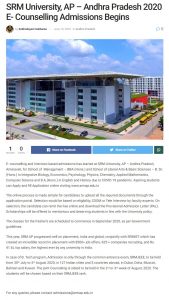
Zee5 – June 13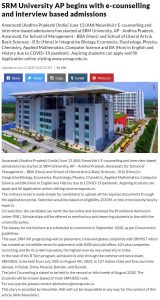
AP News Daily – June 16

Palanaadu Varthalu – June 16

Vartha Prapancham – June 16
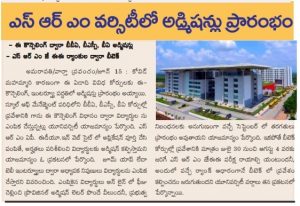
Andhra Bhoomi – June 15

Andhra Prabha – June 15

Nellore News Daily – June 15

The Hawk – June 15

Mangla Times – June 15
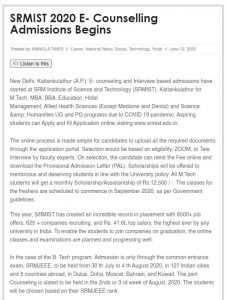
Edex Live – June 15

Business Standard – June 15

Collegedunia – June 15

Deccan Herald – June 14

Global Greenews – June 15
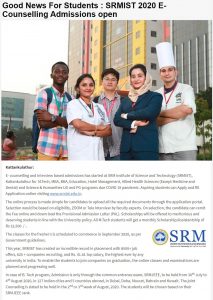
Goa Chronicle – June 15

GraphBuzz – June 15
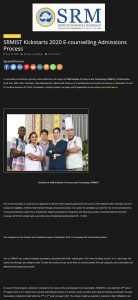
ibtn9 – June 15

Latestly – June 15
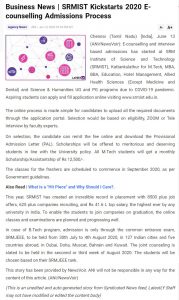
Free Press Journal – June 15

millenniumpost – June 15

Press Trust of India – June 15
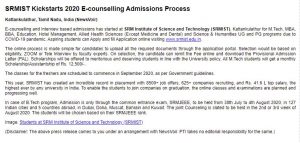
Subhodayam Subbarao – June 15

The Truth One – June 13

The Tribune – June 15

Trinity Mirror – June 13

Virtual Machine – June 13

Mangla Times – June 11
Global Greenews – June 15
Global Greenews – June 11
India Education Diary – June 15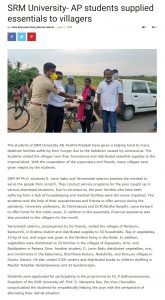
India Education Diary – June 11
Covaimail – June 15
Covaimail – June 11
Collegedunia – June 15
Collegedunia – June 11
Higher Education Plus – June 12
Business Journalist – June 15
Business Journalist – June 12
Andra Prabha – June 11
The very young SRM University-AP is already creating marvels by scaling new heights as a multidisciplinary research university. The 3-year-old university has published six very impactful research papers in a year in Nature Indexed journals. The notable research work helped significantly its sister aka principal institution SRM Institution of Science and Technology acquiring the rank of No.1 private university in India and 21 among Indian universities by the Nature Index 2020. The ranking was done based on Nature Index data from January 1st 2019 to December 31st 2019.

The Nature Index provides a perspective on high –quality research on the basis of published articles. The Nature Index provides a close to real-time proxy of high-quality research output and collaboration.
Nineteen research articles were published by the faculty members of SRMIST and its sister institutes between April 1st 2019 and March 31st 2020. These articles were compiled into a database by Nature Research to create the Nature Index rankings. Out of these nineteen articles, twelve were published by the Faculty Members of SRMIST, KTR Campus. One article was published by a faculty member of SRM University – Sikkim. The rest of the six articles were published by faculty members of SRM University- AP, Andhra Pradesh. Dr Sutharsan Govindrajan, Department of Biological Sciences; Dr Nimai Mishra, Dr S. Mannathan, Dr Mahesh Kumar Ravva, Department of Chemistry; Dr Siddhartha Ghosh and Dr Jatis Kumar Dash, Department of Physics played a pivotal role in achieving the honour for SRM University-AP. It is remarkable that SRM-AP, even in its budding stage, has contributed to around one third of the Nature Index score.
Dr Sutharsan’s paper, “A bacteriophage nucleus-like compartment shields DNA from CRISPR nucleases”, published in Nature, involves the discovery of novel strategies used by bacteriophages (viruses that kill bacteria) to overcome the bacterial CRISPR-Cas system, which are molecular scissors that are programmed to cut DNA. His findings have massive implications on the society as it has the ability to reshape the boundaries of the Phage-therapy in curing diseases.
Dr Mishra has published a paper titled “Broadband Defects Emission and Enhanced Ligand Raman Scattering in 0D Cs3Bi2I9 Colloidal Nanocrystals”. It is about excitonic 0D and 2D lead-halide perovskites that have been recently developed and investigated as new materials for light generation. In this work, a broadband (>1 eV) emission from newly synthesised 0D lead-free colloidal Cs3Bi2I9 nanocrystals (NCs) is reported. Remarkably, evidence of enhanced Raman scattering from the ligands is observed when attached to the NCs surface, an effect that is preliminarily attributed to strong exciton-ligands electronic coupling in these systems. Such interesting properties can be extremely appealing for a new class of low-cost materials suitable for solid-state lightning and sensing applications.
Dr Mannathan’s research article, “Palladium/Copper-Catalyzed Denitrogenative Alkylidenation and ortho-Alkynylation Reaction of 1,2,3-Benzotriazin-4(3H)-ones”, describes an environmentally friendly strategy to access various functionalised isoindolinones and 3-(imino)isobenzofuranones, which are important backbone in many natural products and biological active compounds. These reactions were enabled by an interesting Pd/Cu-cocatalyzed denitrogenative tandem alkynylation/cyclisation sequence. The strategy was also successfully employed to synthesise (Z)-3-benzylideneisobenzofuran-1(3H)-one derivatives in good to high yields.
Dr Mahesh’s paper is named “Harnessing Autoxidation of Aldehydes: In Situ Iodoarene Catalyzed Synthesis of Substituted 1,3,4-Oxadiazole, in the Presence of Molecular Oxygen”. In this study, a new methodology has been developed for the synthesis of substituted 1,3,4-oxadiazoles, which are essential pharmaceutical ingredients. We have modelled the reactivity of reactants, reactive intermediates, and products using computational protocols. Results obtained from these computational protocols are used to predict the reaction pathways and gain insights on the stability of products.
Dr Ghosh published “Direct Growth of Wafer-Scale, Transparent, p-Type Reduced-Graphene-Oxide-like Thin Films by Pulsed Laser Deposition”. His study reveals that reduced graphene oxide (rGO) is a derivative of widely used 2-D material called Graphene. Along with Graphene itself, rGO is also an exciting material for research communities due to its potential application in gas sensing, water purification and desalination, energy storage and flexible electronics. All these novel applications require a reproducible & scalable growth process for rGO thin films. In their research article, they have reported a single-step bottom-up growth process of reduced Graphene Oxide using a thin-film growth technique called Pulsed Laser Deposition (PLD). Utilising the state-of-the-art laser beam scanning technology, they have been able to grow 4-inch wafer-scale rGO thin-films with ultra-smooth surfaces and unparallel thickness uniformity. Moreover, they have found that these rGO thin-films are transparent and conducting with some of the lowest extinction coefficients and refractive index values. They believe this novel growth process combined with the exotic opto-electronic properties (of rGO) will enable us to directly grow and integrate rGO thin-films on Si & metal-oxide based hetero-structures and will potentially move forward the rapid deployment of rGO for various applications.
Dr Dash’s article is titled as “Thickness-Insensitive Properties of α-MoO3 Nanosheets by Weak Interlayer Coupling”. Extensive use of portable electronic products and the rapidly growing commercial markets in smart electric appliances have created a seemingly high demand for flexible, wearable and foldable high-performance photoelectric devices. In the search for new materials to meet these criteria, one promising solution may be the two-dimensional (2D) layered heterostructures, assembled by stacking different conventional 2D materials in hetero-layered architectures. Alpha (α) phase-molybdenum trioxide (MoO3) is one of the promising 2D oxides, which is a chemically stable semiconductor with a high dielectric constant. The high resistive tunnelling and dielectric constant also shows that α- MoO3 nanosheet can be used as a promising dielectric or tunnel barrier. Therefore, the epitaxially grown MoO3 can be an important candidate in the field of 2D materials-based nanoelectronics. α- MoO3 layers can also be used as dielectrics for supercapacitors, and channel materials for high power electronics. Besides these, heterojunctions like Graphene-α- MoO3 and α- MoO3 /MoS2 has its applications in Field effect transistors (FETs), battery cathode materials, and various sensors.
The Nature Index is a database of author affiliations and institutional relationships. The index tracks contributions to research articles published in 82 high-quality natural science journals, chosen by an independent group of researchers. This Index provides absolute and fractional counts of article publication at the institutional and national level and, as such, is an indicator of global high-quality research output and collaboration.
Continue reading →Dr Sandeep Singh Sengar, Assistant Professor, Department of Computer Science and Engineering, is organising a workshop for the enthusiasts on “Deep Learning-based Computer Vision and its Applications” on 19th and 20th June 2020 at 11 a.m. onwards.

One of the main targets of Computer Vision is to interpret the content of Image and Video data. Machine/Deep learning is the science of designing and applying algorithms that can learn things from past cases. The workshop will focus on the concept and understanding of Image and Video Processing, Computer Vision and Deep Learning. In the workshop, participants will gain basic knowledge in the domains as well as hands-on experience in application and problem-solving. Attending the workshop will help participants immensely to come up with innovative ideas, but more importantly, they will have gained knowledge that could instantly set them apart from the crowd. The workshop is an excellent opportunity for those who want to build a career in this domain. In addition to that, research scholars, faculties or industry persons will also be benefitted from the action-oriented discussion and shared knowledge.
Registration Link: https://srmap.zoom.us/meeting/register/tJUvceuspzIrE9I0l6gBgvluSHgMXThsDOE1
Continue reading → Globally, TEDx events are incredibly appealing for their cutting-edge and progressive ideas from the speakers. TEDx carefully curates, magnifies, and develops these ideas, that can genuinely change the world for the better. SRM University AP now joins the TEDx community to take it to an entirely new level.
Globally, TEDx events are incredibly appealing for their cutting-edge and progressive ideas from the speakers. TEDx carefully curates, magnifies, and develops these ideas, that can genuinely change the world for the better. SRM University AP now joins the TEDx community to take it to an entirely new level.
A TEDx event is a local gathering where live TED-like talks and performances are shared with the community. TEDx events are thoroughly planned and coordinated independently, on a community-by-community basis. The content and design of each TEDx event is unique and developed independently, but all of them are expected to abide by the standards and rules set by TED. This event can be extremely advantageous to the university not only in terms of the knowledge that the talks bring but because of the ambience, optics & publicity that it provides.

“We’ve been working towards acquiring the license for months, and we are pleased to inform that our application for TEDxSRMUniversityAP has finally been approved! The application process involved presenting our ideas and defending the questions by the representatives at TED. Overall, it was a good experience,” said Dr Bhanukiran, Assistant Professor in the Department of Computer Science and Engineering. This license permits SRM University- AP to organise one TEDx event within the next 12 months which means it is valid till May 12, 2021, and allows an attendee limit up to 100.
SRM University- AP is now setting up a dedicated website for the event where all the information will soon be announced. The students, staff and faculty are all thrilled to facilitate the event. The TEDx team will meet soon to discuss and finalise the details of the event.
Continue reading →


